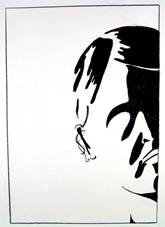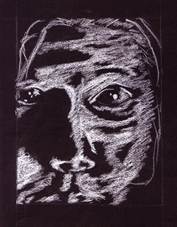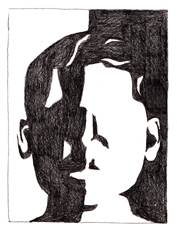2-tone Value: Module 1 Analogue Exercise
Value is a measure of relative lightness or darkness. It is determined by both the color of the object as well as the degree and intensity of light that is reflected or cast on the object. Value is not only defined by highlight, but of areas of shade and shadow as well. It is important when drawing from observation with black and white media not to confuse local color with value.
LOCAL COLOR = describes how light or dark a surface’s material and color actually are.1
VALUE = relative lightness or darkness of an object, regardless of its color.
For example, both the red of an apple and the green of a leaf can have the same value, but are very different in hue and in their reaction to light. In this week of exercises we will not draw an object’s color, but will relax our eyes and focus only on the shapes of light, shapes of shade, and shapes of shadow. From these shapes the form of the object will be suggested.
Value contrasts are one of the most important elements in composition. They typically are read first in a composition, before the object’s line, detail, and texture. Your eye tends to read areas of high value contrast first [where it is most light, and where it is most dark.] Squinting while looking through your viewfinder will isolate your composition’s value relationships and may be useful in blurring the details in order to only see the juxtaposition of light and dark areas.
In order to understand the power of value in drawing, it is helpful to make value scales in several media to practice rendering the full range of values. A value scale is a black to white gradient or series of steps. On one end is the white of the paper and on the other end is pure opaque black. A value scale can be made using one pencil or a series of pencils of varying softness. You can also use ink and water with a brush, felt-tip and ballpoint pens, or charcoal. When using drawing tools with small points [like pens], it is a good idea to create value with marks like hatching or dots rather than trying to cover the surface of the paper like you would with a brush or conte crayon.



SUBTRACTIVE DRAWINGS/WHITE ON BLACK
Sometimes it is useful when working with value, to take the opposite approach. The standard method of drawing is to make dark marks on white paper. This is an additive process. In subtractive value drawing, you begin with a dark ground and draw with your erasure or white utensil. This method produces luminous, evocative drawings. This method will have you draw the light [rather than drawing the shade and shadow in previous exercises] and in return the form will be automatically revealed.
GUIDELINES FOR A VALUE MAP
- Use a viewfinder to create a composition. Squint if you are having trouble distinguishing values. [What is light, medium, and dark?]
- Draw your frame on the paper with the same proportions as your viewfinder.
- Determine the number of values you will use in your drawing. [This assignment deals with only 2 values [black and white.] Once determined, make a value map on the side of your page
- Look carefully at your subject and group the infinite range of tones into VALUE SHAPES. Using drawing as a process it is suggested you:
- Use your viewfinder.
- Use gesture lines to organize the outline of shapes in relationship to your frame on the page.
- Use contour line to enclose the shapes that you see before you choose a value.
- Draw each shape with a single value and a decisive edge. Then begin to identify where and when blending is necessary.
**Remember that using value maps is a method of simplifying a complex form into a set numbers of various shapes depending on the number of values used. Therefore, the less number of value used, the more abstract the composition. The shapes are less likely to bleed together if you use several values.
QUESTIONS FOR EVALUATING A VALUE MAP DRAWING
- Are the shapes a single value from edge to edge?
- Are there any blended or smudged areas?
- Is the number of values clear in the drawing? [Shows discipline in value control and critical analysis of value differences.]
- Is the composition strong?
- Is there a distinction made between value and local color?
ASSIGNMENT
Draw three self-portraits using a 2-value map, STRONG directional lighting, and a mirror.
With each self-portrait, change the perspective, light direction, and composition of your face.
- Drawing 1: drawing must be done on your white paper with black ebony pencil or charcoal.
- Drawing 2: Subtractive drawing. [Covering white paper with charcoal use your erasures too distinguish light from shadow.]